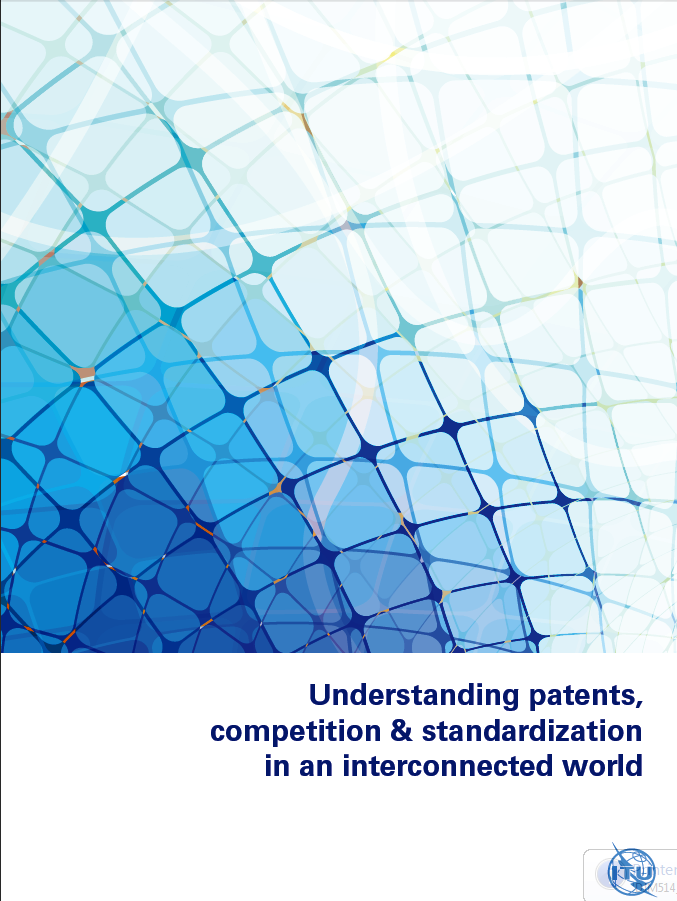Understanding patents, competition and 
standardization in an interconnected world
Released 1 July 2014
The publication provides government officials, private-sector executives and industry analysts of all disciplines with an overview of the current state of play in the interrelationship of intellectual property and standardization in the ICT sphere.
Parts I and II provide the conceptual underpinnings of Part III, which analyses ensuing debates and litigation concerning the interplay of patents and standards. Part IV is relevant to current and potential participants in ITU’s standardization work.
The publication explores recent years’ uptick in litigation involving standard-essential patents (SEPs) and offers readers a basis with which to understand contemporary tensions and conflicts surrounding the inclusion of patented technology in standards.
Patent holders’ licensing their SEPs to standards implementers on reasonable and non-discriminatory (RAND) terms is a cornerstone of the standards development process. “Understanding patents, competition and standardization in an interconnected world” provides the introduction necessary to engage with ITU’s ongoing evaluation of possible reform to the ITU-T/ITU-R/ISO/IEC Patent Policy and related Guidelines.
Part I: Standards and standards development (pp. 11-29)
‘Technical standards’ establish norms and requirements for technical systems, specifying standard engineering criteria, methodologies or processes. Traditionally most prevalent in the fields of information and communication technology (ICT) and consumer electronics, technical standards are finding new relevance in supporting the rollout of ICT-enabled services in areas such as healthcare, transportation and energy.
Part I provides an introduction to the conceptual foundations of standardization; the purpose and impact of standardization in the ICT industry and global economy; the composition of the modern ICT standardization landscape; the principles governing standardization processes; and the possible advantages and disadvantages of technical standardization.
Part II: General concepts of patent law and competition law (pp. 31-47)
Patent law, competition law and standardization systems are designed to support and incentivize innovation and technological progress. The patent system rewards creativity, and patents can be used as a measure of the rate of innovation or knowledge accumulation. Competition law discourages collusive or monopolistic market behaviour that adversely affects competition and innovation. Competition law encourages innovation by prohibiting market behaviour (‘conduct’) that restricts access to a market or otherwise negatively affects domestic or international trade.
Part II provides an introduction to patents and the requirements of patentability; the organization of the global patent system, and the challenges it is facing; the general rules and mechanisms in competition law; and how competition law is applied to standards development processes and the inclusion of patents in standards.
Part III: The interplay between patents and standards (pp. 49-76)
Standards are viewed by many as quasi-public goods, and, in the ICT context, standards are often not implementable without access to proprietary technology protected by patents. Targeting a balance between the interests of intellectual property rights (IPR) holders and standards implementers, most standards bodies have established IPR or patent policies that provide a framework for the inclusion of IPR-protected technology in standards.
Recent years have witnessed noticeable growth in tensions and conflicts surrounding the incorporation of patented technology in standards. The global ICT industry has played host to an upsurge of standards-related patent litigation, particularly among parties active in the mobile and tablet markets.
Part III provides an introduction to standard-essential patents (SEPs); how IPR policies based on reasonable and non-discriminatory (RAND) patent licensing aim to create and protect a fair balance between stakeholders’ varied interests; and the nature of conflict between stakeholders, both from the perspectives of patent owners and standards implementers.
Part IV: A closer look at ITU’s standardization activities and its patent policy (pp. 77-92)
ITU standards development is driven principally by private-sector members that come together to develop the standards that the industry needs to progress. Standards work is initiated in response to contributions from members, and decisions to take on new work or approve standards are made by consensus.
ITU, ISO and IEC – the only formal SDOs responsible for global ICT standards – have developed a common patent policy and related guidelines, adopted in 2007. The policy rests on a commitment-based approach. A disclosure process aims to identify all patents essential to standards under development, and a commitment process seeks declarations from SEP holders that they are willing to grant licenses to these patents on RAND or Royalty-Free (RF) terms.
Part IV provides an introduction to well-known ITU achievements in global ICT standardization; key principles and provisions of the ITU/ISO/IEC common patent policy; and the differences between the various options for licensing commitments, including reciprocity clauses.
Download here